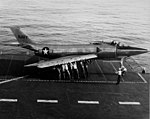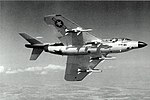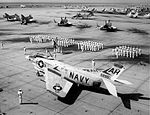McDonnell F3H
| McDonnell F3H / F-3 Demon | |
|---|---|
 F3H-2 of the VF-64 squadron of the " USS Midway " |
|
| Type: | Fighter plane |
| Design country: | |
| Manufacturer: | |
| First flight: |
August 7, 1951 |
| Commissioning: |
March 1956 |
| Production time: |
1956 to 1959 |
| Number of pieces: |
517 |
The McDonnell F3H Demon (Eng .: demon) was a carrier-based all - weather fighter aircraft of the United States Navy . It was the successor to the McDonnell F2H Banshee and was used by the US Navy from 1956 to 1964. The F3H was the US Navy's first all-weather fighter with radar.
development
Development of the Demon began on September 30, 1949, when the US Navy, after examining a dummy, ordered two slightly modified prototypes of an interceptor from McDonnell, which should be on par with land-based aircraft. The Navy had already issued a specification for this in May 1948, in which McDonnell prevailed against ten other designs with his design Model 58 . The aircraft was designed around the Westinghouse J40 engine under the direction of Richard Deagan . At 6,350 kp, this had around three times more thrust than the two Westinghouse J34 -WE-34s of the McDonnell F2H. The F3H was McDonnell's first swept wing design and the first American aircraft with missile armament .
The prototype XF3H-1 flew for the first time on August 7, 1951, the second in January 1952. The prototypes and their drives showed numerous technical defects, which meant that the tests had to be frequently interrupted and modifications made. The flight tests of the first series machine began on September 24, 1953. The prototypes flew with the afterburnerless XJ40-WE-6 engine (replaced on the second series machine in January 1953 by a 46.7 kN strong J40-WE-8) for the The series version was the J40-WE-24 with a significantly higher thrust. However, this engine was never built and the 56 F3H-1N series aircraft were equipped with the J40-WE-22 instead. This only achieved half of the required power, otherwise it got too hot. Of 35 F3H-1Ns delivered, eight crashed and three pilots died. The first prototype was lost in March 1954 due to an engine explosion. The machines were then banned from starting until a new engine was available. The choice fell on the 63.4 kN Allison J71 engine. 29 more F3H-1N were converted to the J71. In addition, the ejection seat was replaced by a Martin-Baker model. The F3H-1N remained on the ground from July 1955 and were never put into service. The 239 newly delivered machines with the J71 were given the designation F3H-2N . A prototype of the 2N flew for the first time on April 23, 1955, the first series machine followed in June 1955. Compared to the 1N, the series machines had an 18% larger wing area. All F3H-2N were serially equipped with the Hughes AN / APG-51 radar, instead of the AN / APG-30 , and armed with four 20 mm cannons. The F3H-1 was a pure interceptor, the F3H-2N with four lower wing stations and two additional drop tanks under the fuselage could also be used as a fighter-bomber.
The US Navy received 95 F3H-2Ms , the prototype of which took off on its maiden flight on April 23, 1955 and which could be equipped with radar-guided AIM-7C Sparrow-I missiles. For the semi-active radar steering required for this, the radar was modified to the AN / APG-51B. The first F3H-2M was delivered to the Navy Missile Center at Point Mugu, California in February 1956. In March 1956, the VF-14 was the first squadron to be equipped with the F3H-2N. This version was only suitable for all weather conditions and equipped with four infrared -controlled AIM-9B Sidewinder . The last version to be produced was the F3H-2 (without additional letter) , which was tested from September 1956 . This could use AIM-7-Sparrow-III and Sidewinder AIM-9B missiles, but was optimized for the fighter-bomber role and could carry 2722 kg external loads. Of this version 236 pieces were produced, the last of which was delivered in April 1960.
The machines were used in the fighter squadrons of the US Navy (eight in the Atlantic, 14 in the Pacific Fleet and five in test and training units) until September 1964, but saw no combat missions. However, they flew over Lebanon and Quemoy in 1958.
When the designation system of the US armed forces was standardized in 1962, the F3H became the F-3 . As the last season, VF-161 Chargers was converted to the McDonnell F-4B Phantom II in September 1964 .
Versions
- XF3H-1
- Prototype, 2 built.
- F3H-1N
- Fighter aircraft with Westinghouse J40 WE 22 engine, 56 built. 29 later received the J71 engine.
- F3H-1P
- not built reconnaissance version of the F3H-1.
- F3H-2 (F-3B)
- Fighter-bombers with Allison-J71-A-2E engines, 239 were built.
- F3H-2M (MF-3B)
- Fighter-bomber with the ability AIM-7 Sparrow fire -air-air missiles, 95 were built.
- F3H-2N (F-3C)
- Fighter-bomber with the ability AIM-9 Sidewinder fire -air-air missiles, 125 were built.
- F3H-2P
- Unbuilt reconnaissance version of the F3H-2.
- F3H-3
- not built fighter-bomber.
Technical specifications
| Parameter | Data from the McDonnell F3H-2 Demon |
|---|---|
| crew | 1 |
| length | 17.98 m |
| span | 10.77 m |
| Wing area | 41.1 m² |
| height | 4.45 m |
| Empty mass | 9,656 kg |
| Takeoff mass | 14,127 kg |
| Max. Takeoff mass | 17,700 kg |
| drive | an Allison J71 -A-2 with 62.2 kN thrust |
| Top speed | 1,152 km / h |
| Climb performance | 65 m / s |
| Service ceiling | 13,000 m |
| Range | 2,900 km |
| Armament | 4 × 20 mm Colt Mk-12 cannon 2,720 kg bombs |
gallery
literature
- Gordon Swanborough, Peter M. Bowers : United States Navy Aircraft since 1911. Naval Institute Press, Annapolis 1990, ISBN 0-87021-792-5 , pp. 325 ff.
Web links
Individual evidence
- ↑ a b c Unloved demon. McDonnell F3H Demon . In: US naval fighter planes 1945 to today (= FliegerRevue ). tape November 17 , 2012, p. 52-55 .




